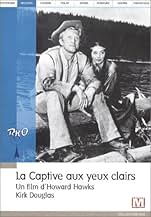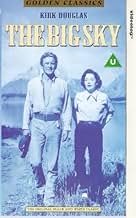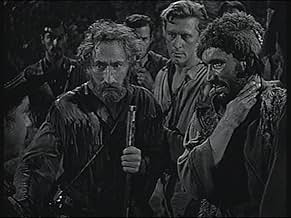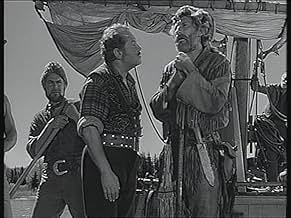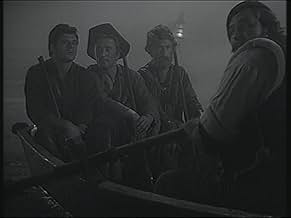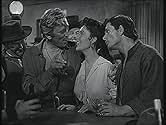La réussite du voyage est liée à la survie de la jeune fille indienne ainsi que sur leur capacité à mener à bien des échanges commerciaux avec les Pieds-Noirs.La réussite du voyage est liée à la survie de la jeune fille indienne ainsi que sur leur capacité à mener à bien des échanges commerciaux avec les Pieds-Noirs.La réussite du voyage est liée à la survie de la jeune fille indienne ainsi que sur leur capacité à mener à bien des échanges commerciaux avec les Pieds-Noirs.
- Réalisation
- Scénario
- Casting principal
- Nommé pour 2 Oscars
- 3 nominations au total
- Blackfoot Dancer
- (non crédité)
- Horse Trader
- (non crédité)
- Tavern Patron
- (non crédité)
- Tavern Proprietor
- (non crédité)
- Tavern Patron
- (non crédité)
- Jailer
- (non crédité)
- Blackfoot Subchief
- (non crédité)
- Pascal
- (non crédité)
Avis à la une
But in my opinion The Big Sky stands on the level of Howard Hawk's best work remarkable for its visual beauty (though filming it in colour would definitely improve it), fine performances (Kirk Douglas is magnificent here and it's hard to imagine other actor playing this role), wonderful music from Dimitri Tiomkin and interesting story of, basically, friendship, that even might be called love, between the two main characters of Jim Deakins (Kirk Douglas) and Dewey Martin (Boone Caudill) but friendship on a background of a perilous and adventurous journey up the Missouri river to the Indian territory where no white man ever set his foot before, with a group of peculiar French adventurers and an Indian princess Teal Eye (Elizabeth Threatt) who steals their hearts and threatens their friendship.
A must see classic. 9/10
The Big Sky was RKO Pictures big production for 1952. I'd like to say that Howard Hughes spared no expense in making this film, shooting a good deal of it in the Grand Tetons, the actual location for the adventures of many fur trappers. But for the life of me I don't understand why Hughes and RKO after doing that, didn't spring for color.
Possibly because director Howard Hawks wanted black and white. His last epic film Red River had done well in black and white. Still I really think something was missed. RKO did use color on films with a lot less budget.
There's a lot of similarity between The Big Sky and Red River. Both films involve a group of men on an epic journey into the unknown for business reasons. In Red River, John Wayne has to get that huge herd to market and has to use a trail few have used. In The Big Sky a group of independent trappers basically want to land a nice fur contract with the Blackfeet Indians where few whites have gone up the Missouri River. Going against them is a fur trading consortium kind of like the one John Jacob Astor put together.
The trappers are mostly French Canadian Metis headed by Steven Geray, but also along is Arthur Hunnicutt who speaks the Indian language. Their ace in the hole is Elizabeth Threatt, a Blackfoot princess the trappers have rescued and are bringing back to her people in the hopes that her old man will be grateful. Hunnicutt is also the narrator of the film.
Douglas and Dewey Martin join up with the group in St. Louis and the trappers have the usual adventures as they take the flatboat up into the Missouri River country. The scenes showing journey upriver are nicely photographed.
Two others in the cast merit attention. Hank Worden does a nice job as a lost Blackfoot Indian who the trappers pick up. He may not be playing with a full deck, but he does come in handy. Jim Davis is one lean and mean villain as the company troubleshooter who wants to keep the independents out.
Arthur Hunnicutt got an Oscar nomination for Best Supporting Actor for his role, The Big Sky proved to be his career film. Unfortunately he lost to Anthony Quinn for Viva Zapata. Still Hunnicutt's folksy charm was always something to look forward to in any film he was ever in.
The Big Sky is one of the best films ever done about the mountain man era of the American frontier. If they'd only spent for color.
"The Big Sky" was filmed on location, and this alone makes the film worth watching, for the splenor of the Snake River and Grand Tetons, where the film was actually shot, is breathtaking.
But "The Big Sky" has other virtues which raise it far above the average "scenic". First, is the multi-layered plot. Besides the story of an enterprise, "The Big Sky" is about how men, in a time long past, interacted, when their differences were subordinated to a higher purpose. Second, is director Howard Hawks, whose trademark "naturalistic dialogue" technique is put to wonderful use here. Hawks works on complex relationships - male and female, "Frenchie" and Anglo backwoodsmen, Native Americans and whites - like a conductor a symphony. Third, and perhaps most touching, is the tale of male bonding not only among the group of men, but one-on-one between Jim Deakins, played by Kirk Douglas, and Boone, his young sidekick, played by Hawks protegé Dewey Martin. There's a nice, touching story toward the end.
This is a shamefully underrated film. Superb cinematography (Oscar nominated), rich plot, flawless casting (Arthur Hunnicutt nominated for Best Supporting Oscar), masterful direction, make "The Big Sky" a true classic.
Le saviez-vous
- AnecdotesWhile shooting La Rivière rouge (1948), there was a scene that director Howard Hawks unsuccessfully urged John Wayne to do. It involved his getting a finger mangled between a saddle horn and a rope, resulting in Walter Brennan's amputating it. Hawks reportedly told Wayne, "If you're not good enough, we won't do it", but Wayne wouldn't do it. According to Hawks biographer Todd McCarthy, Hawks did get Kirk Douglas to do that scene in this film, and it came off so funny that Wayne later declared to Hawks, "If you tell me a funeral is funny, I'll do a funeral."
- GaffesJim expresses amazement at the size of St. Louis. However, he had just come from Louisville, which in 1832 was about twice the size of St. Louis, so it should not have been a source of such astonishment.
- Citations
Zeb Calloway: Blackfeet... proud injuns. They ain't gonna let no white man spile their country. The only thing they'a feared of is a white man's sickness.
Boone Cardell: What's that?
Zeb Calloway: Grabs. White men don't see nothing pretty unless they want to grab it. The more they grab, the more they want to grab. It's like a fever and they can't get cured. The only thing for them to do is to keep on grabbin' until everything belongs to white men and then start grabbin' from each other. I reckon injuns got no reason to love nothing white.
- Crédits fousInstead of the traditional RKO morse code sound, the film's opening theme music is played over the RKO radio tower image. Later, a title card is displayed explaining the premise of the story.
- ConnexionsReferenced in Pour la peau d'un flic (1981)
Meilleurs choix
Détails
- Date de sortie
- Pays d’origine
- Langues
- Aussi connu sous le nom de
- Les hommes de l'ouest
- Lieux de tournage
- Sociétés de production
- Voir plus de crédits d'entreprise sur IMDbPro
Box-office
- Budget
- 2 000 000 $US (estimé)
- Durée2 heures 20 minutes
- Couleur
- Rapport de forme
- 1.37 : 1
Contribuer à cette page



